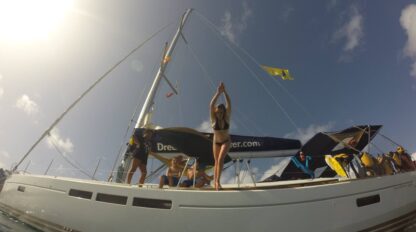History of Piracy in the BVI

The history of the BVI is filled with tales of piracy, but the last major recorded act of piracy was in 1869. At Sail Caribbean teen summer adventure programs, we like to have a little fun and celebrate the rich culture of the area with our very own Pirate Days! What better way to understand the daily life of a pirate than by living on the boat you sail through the very islands famous historical pirates stopped at? It’s a little strange to think of this popular sailing and vacation spot as a pirate’s lair; but it’s also easy to imagine why pirates spent time in the Virgin Islands. Lots of safe harbors, short climbs to excellent spying locations, and a shipping channel where Spanish treasure boats frequently sailed by – all very tempting for a pirate!
As you can probably imagine, most pirates did not keep good records, so it’s sometime difficult to separate fact from legend. However, even if the stories have been steeped in mystery and the specifics buried at sea ages ago, we still know a little of what went on here and most of it happened between 1580-1730.
In fact, if you’ve spent much time in the British Virgin Islands, you’ll recognize the names of Norman, Sir Francis Drake, Jost Van Dyke, and Thatch to name a few. All of these islands and the shipping channel in the BVI are named after well known pirates! These men and many others (even a few women!) adapted to the natural resources provided by the islands. For example, many pirates built their boats with a shallow draft so they could skim over the tops of shallow reefs; ships of similar size would attempt to follow the pirates (hoping to capture and imprison them) over the reef and immediately run aground. Of course, the pirates would then quickly heave to and proceed to plunder the grounded ship!
Spanish pirates in the late 1600’s caused lots of problems for the BVI. Twice in two years, Spanish pirates attacked Tortola and the second time nearly destroyed the small colony. Many of the British “pirates” were actually Privateers – sailors given letters of Marque by their government to loot enemy ships. Most of these sailors were previously part of the Navy but when the Navy was downsized many sailors were out of a job – unless they became privateers. Even men working as planters on the Virgin Islands were issued letters of Marque so they too could serve their country by looting enemy ships. Some of the men, however, began looting neutral countries ships as well which was considered ‘piracy,’ cancelling their letter of Marque and was punishable by death.
Blackbeard – His real name was Edward Teach or Thatch- no one really knows for sure, but both Great Thatch and Little Thatch islands are named after him. He turned to piracy after Queen Anne’s War sometime after 1714. The deep harbor at Soper’s Hole was his main hideout where he would wait hidden from view of the shipping channel but within close reach of the Spanish treasure ships passing through. He supposedly marooned 15 men on Dead Chest just across from Hodge’s Creek Marina on Tortola. In 1718, his ships ran aground off the coast of North Carolina where they have recently been found – visit this website to see what artifacts have been recovered from the archeological site.
Owen Lloyd – He’s one of the most famous and best documented pirates of the BVI. He and some of the crew of a treasure ship mutinied, stealing the treasure. They tried to hide some of it on St. Croix and then stopped over on Norman island to hide the rest there (Norman Island is also the inspiration for the popular book, Treasure Island). They fled to St. Eustacius where they were captured and the treasures were collected by the President of Tortola and island planters. Unfortunately, the British government took the treasure back to the Queen, but left a small portion behind as payment to the islanders. There’s supposedly still a copy of the receipt on Tortola.
Sir Francis Drake – A British sailor, knighted for his naval accomplishments including sailing completely around the world between 1577-1580. He especially focused on tormenting Spanish treasure fleets and the Spanish Armada, to which he caused significant damage. He apprenticed under John Hawkens and so spent a good deal of time around the BVIs. He died in the Caribbean in 1596 spending some time in the Virgin Gorda North Sound trying to recover from the flu that eventually killed him.
John Hawkens – He spent a lot of time sailing in the BVI, some of the time with Sir Francis Drake. One of the things he is best known for is redesigning ships to be faster, lighter, and shallower to be better suited for overtaking other ships and maneuvering around the shallow reefs of the Caribbean.
Jost Van Dyke – He used the harbors of the island named after him to hide and make repairs. As was fashionable at the time, he focused his attention on Spanish treasure ships.
Information sourced from Wikipedia and Charter Advisors.

